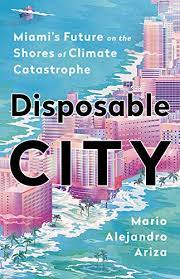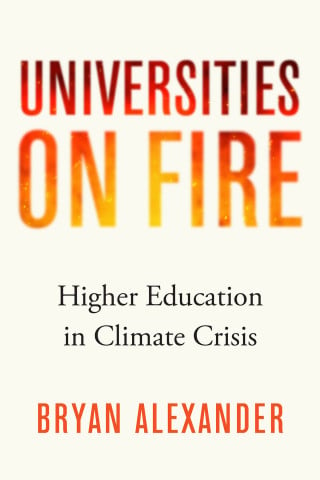You have /5 articles left.
Sign up for a free account or log in.
 Disposable City: Miami's Future on the Shores of Climate Catastrophe by Mario Alejandro Ariza
Disposable City: Miami's Future on the Shores of Climate Catastrophe by Mario Alejandro Ariza
Published in July of 2020.
Bryan Alexander's Universities on Fire: Higher Education in the Climate Crisis is among the most anticipated books of the coming year.
While we wait for the March 28th, 2023 release date of Bryan's book, we can keep having the conversation (that Bryan is leading) on higher ed and climate change.
Disposable City: Miami's Future on the Shores of Climate Catastrophe is a book we might want to discuss.
What reading Disposable City did for me was to help make the coming impact of climate change more tangible, immediate, and terrifying. The brilliance of Disposable City is that the book zooms in on a single place, localizing and specifying the likely impacts of sea rise and extreme weather.
I'm looking forward to reading Bryan's book to connect climate change directly to issues of resilience and sustainability for our colleges and universities. If academia is in for any of the heat, weather, and ocean level rises that Miami will face in this century, we need to start preparing now.
Before reading Disposable City, climate change was not the first thing I'd think of when thinking about Miami. What comes to mind when we think of Miami is luxury real estate and tourism. Will Smith never talks about a coming climate catastrophe in his 2011 hit song.
Mario Alejandro Ariza is ideally situated to guide us through what Miami will likely experience when the water, storms, and heat overwhelm the city's infrastructure. A journalist who came to Florida as a kid from the Dominican Republic, Ariza is deeply ingrained in Miami's culture. Ariza's parents transformed themselves into successful real estate agents. He knows firsthand how the Miami luxury real estate market for oceanfront condos seems to keep expanding.
Some of the best chapters of Disposable City involve exploring why Miami residents, and by extension, the rest of us in the US, seem to discount the future so heavily.
This discounting goes beyond a failure to price in the likely impact of the ocean flowing into the foundations and lower floors of apartments and homes with a view of the water. At every level, the complex governmental, insurance, and finance structures that underpin the real estate market seem incapable of grasping that the water is coming.
The depressing conclusion that Ariza comes to in Disposable City is the groups most likely to suffer most as the water rises are the people least equipped to cope. Miami is one the most stratified cities in the US, with a small concentration of highly wealthy celebrity financiers and real estate developers (and celebrity entertainers and athletes), all served by armies of low-paid service workers.
When we think of Miami, we think of Gloria Estefan and Shakira, where we should be picturing the baristas, maids, and waiters that make up the vast majority of the city's low-wage workforce.
The working poor and the struggling middle class, not to mention those families living below the poverty line, will have little ability to cope with the consequences of extreme weather. Already among the country's most cost-burdened places for housing, those living and working in Miami have few options to move to climate-resilient areas.
One trend document in Disposable City is climate gentrification. Properties at higher elevations and are therefore safer from rising sea levels are becoming unaffordable for most residents.
The wealthy continue to bid up prices on oceanfront condos, but at the same time, they are buying properties in the previously working class and heavily nonwhite areas away from the coast. In Miami, affluence buys some insulation from climate change.
How the concept of climate gentrification will play out in our already wealth-concentrated and highly unequal system of higher education is fascinating (and depressing) to ponder.
Maybe the next gathering on climate change and higher ed should take place in Miami.
What are you reading?




